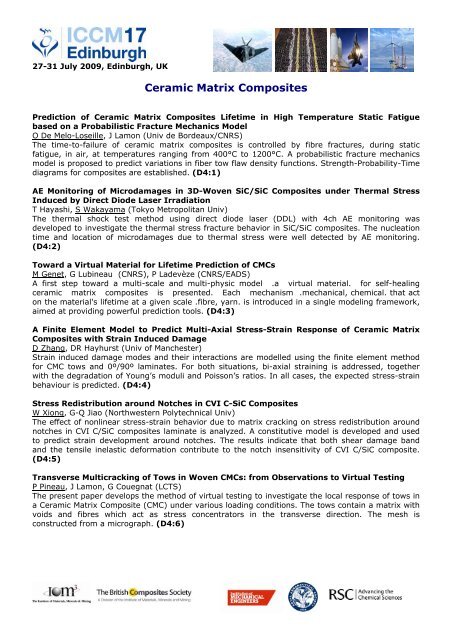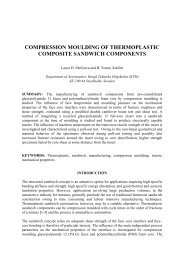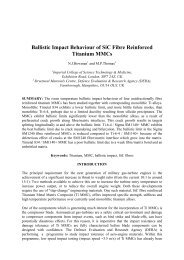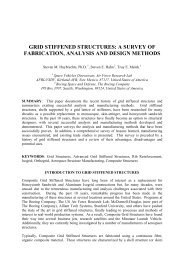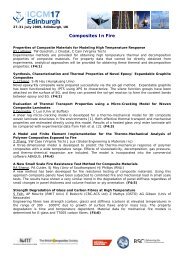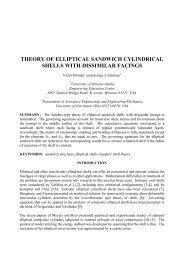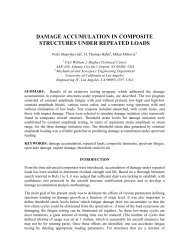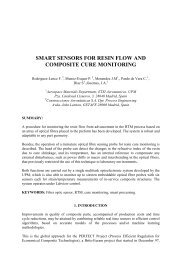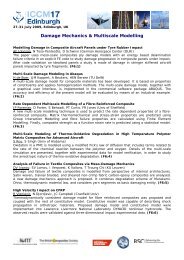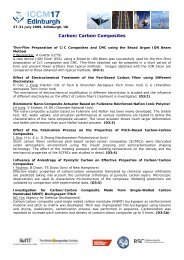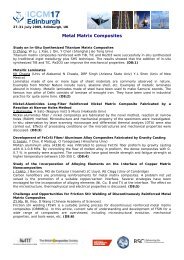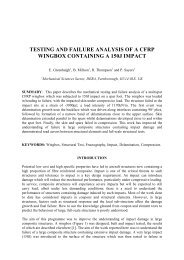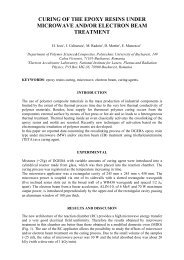Ceramic Matrix Composites.pdf - ICCM
Ceramic Matrix Composites.pdf - ICCM
Ceramic Matrix Composites.pdf - ICCM
Create successful ePaper yourself
Turn your PDF publications into a flip-book with our unique Google optimized e-Paper software.
27-31 July 2009, Edinburgh, UK<br />
<strong>Ceramic</strong> <strong>Matrix</strong> <strong>Composites</strong><br />
Prediction of <strong>Ceramic</strong> <strong>Matrix</strong> <strong>Composites</strong> Lifetime in High Temperature Static Fatigue<br />
based on a Probabilistic Fracture Mechanics Model<br />
O De Melo-Loseille, J Lamon (Univ de Bordeaux/CNRS)<br />
The time-to-failure of ceramic matrix composites is controlled by fibre fractures, during static<br />
fatigue, in air, at temperatures ranging from 400°C to 1200°C. A probabilistic fracture mechanics<br />
model is proposed to predict variations in fiber tow flaw density functions. Strength-Probability-Time<br />
diagrams for composites are established. (D4:1)<br />
AE Monitoring of Microdamages in 3D-Woven SiC/SiC <strong>Composites</strong> under Thermal Stress<br />
Induced by Direct Diode Laser Irradiation<br />
T Hayashi, S Wakayama (Tokyo Metropolitan Univ)<br />
The thermal shock test method using direct diode laser (DDL) with 4ch AE monitoring was<br />
developed to investigate the thermal stress fracture behavior in SiC/SiC composites. The nucleation<br />
time and location of microdamages due to thermal stress were well detected by AE monitoring.<br />
(D4:2)<br />
Toward a Virtual Material for Lifetime Prediction of CMCs<br />
M Genet, G Lubineau (CNRS), P Ladevèze (CNRS/EADS)<br />
A first step toward a multi-scale and multi-physic model .a virtual material. for self-healing<br />
ceramic matrix composites is presented. Each mechanism .mechanical, chemical. that act<br />
on the material's lifetime at a given scale .fibre, yarn. is introduced in a single modeling framework,<br />
aimed at providing powerful prediction tools. (D4:3)<br />
A Finite Element Model to Predict Multi-Axial Stress-Strain Response of <strong>Ceramic</strong> <strong>Matrix</strong><br />
<strong>Composites</strong> with Strain Induced Damage<br />
D Zhang, DR Hayhurst (Univ of Manchester)<br />
Strain induced damage modes and their interactions are modelled using the finite element method<br />
for CMC tows and 0º/90º laminates. For both situations, bi-axial straining is addressed, together<br />
with the degradation of Young’s moduli and Poisson’s ratios. In all cases, the expected stress-strain<br />
behaviour is predicted. (D4:4)<br />
Stress Redistribution around Notches in CVI C-SiC <strong>Composites</strong><br />
W Xiong, G-Q Jiao (Northwestern Polytechnical Univ)<br />
The effect of nonlinear stress-strain behavior due to matrix cracking on stress redistribution around<br />
notches in CVI C/SiC composites laminate is analyzed. A constitutive model is developed and used<br />
to predict strain development around notches. The results indicate that both shear damage band<br />
and the tensile inelastic deformation contribute to the notch insensitivity of CVI C/SiC composite.<br />
(D4:5)<br />
Transverse Multicracking of Tows in Woven CMCs: from Observations to Virtual Testing<br />
P Pineau, J Lamon, G Couegnat (LCTS)<br />
The present paper develops the method of virtual testing to investigate the local response of tows in<br />
a <strong>Ceramic</strong> <strong>Matrix</strong> Composite (CMC) under various loading conditions. The tows contain a matrix with<br />
voids and fibres which act as stress concentrators in the transverse direction. The mesh is<br />
constructed from a micrograph. (D4:6)
27-31 July 2009, Edinburgh, UK<br />
Thermomechanical and Fatigue Testing of <strong>Ceramic</strong> <strong>Matrix</strong> <strong>Composites</strong> (CMCs) in<br />
Combustion Environment using a Unique Combustion Materials Test Facility<br />
T Kim, L Zawada (US AFRL) S Mall (US Air Force IoT)<br />
This study characterizes fatigue properties and oxidation degradation of two SiC/BN/SiC CMCs with<br />
Sylramic-based fibers in a set combustion condition facilitated by the AFIT/AFRL Burner Rig used to<br />
simulate typical engine hot section service environment. The two CMCs differing by the existence of<br />
in-situ BN fiber coating exhibited different results. (D4:7)<br />
Effect of Impregnation of Pitch-Derived Carbon <strong>Composites</strong> with Polysiloxane-based<br />
Preceram on their Microstructure, Mechanical Properties and Oxidation Resistance<br />
T Gumula, S Blazewicz, D Mikociak (UCI/AGH) J Michalowski (IFJ)<br />
New pitch-based C/C composites were obtained from domestic pitches. These composites were<br />
impregnated with different polysiloxane-based solutions of preceram and subjected to heat<br />
treatment up to 1700°C. Microstructure, mechanical properties and oxidation resistance of the<br />
composites were investigated. (D4:8)<br />
Thermal Shock and Oxidation Resistant Gradient Coating based on Yttrium Silicate for<br />
C/SiC Composite<br />
X Zheng, Y Du, W Zhang (National Univ of Defense Tech)<br />
A novel yttrium silicate coating system is designed and fabricated by microwave sintering. BAS glass<br />
is adopted as the sintering additive to decrease the sintering temperature and make the coating<br />
denser, and celsian enhances the high temperature resistance. Green tape is firstly used to get<br />
homogenous coating with designed thickness on components. (D4:9)<br />
Multilayer Sic-Mosi2 <strong>Composites</strong> Produced by Tape Casting<br />
A Antonini, S Biamino, M Pavese, P Fino, C Badini (Politecnico di Torino)<br />
The study presents the results of the analysis of SiC-MoSi2 composites with multilayer structure<br />
produced by tape casting. The effect of different content of SiC and MoSi2 was investigated, as well<br />
as the result of alternating composite and SiC layers. The practicability of a Functionally Graded<br />
Material production was also considered. (D4:10)<br />
Shape Transformation and Total Dissolution of Metallic Nanoparticles in Glass by Strong<br />
Electric Fields<br />
G Seifert, H Graener, S Wackerow, A Stalmashonak (Martin-Luther-Univ)<br />
Silver nanoparticles embedded in glass were transformed to ellipsoidal shapes by ultrashort laser<br />
pulses; applying strong dc electric field, the particles could also be dissolved leaving nanovoids in<br />
the matrix. The key processes at the glass-metal interface and the application potential of the<br />
techniques are discussed. (D4:11)<br />
Microstructure and Mechanical Strength of Vacuum Brazing Bonded Ti3SiC2 Joints using<br />
Al Interlayer<br />
L Shi, Y Zhong, J Yu, X He (HIT)<br />
Ti3SiC2 is one of the nanolayered ternary ceramics Mn+1AXn, where M is a transition metal, A is an<br />
A-group (mostly IIIA or IVA) element, and X is C or N. It possesses a unique combination of the<br />
merits of both metals and ceramics. (D4:12)<br />
SiC-ZrB2 Fiber-Reinforced <strong>Composites</strong> Prepared by Spark Plasma Sintering<br />
SH Lee, HD Kim (KIMS) Y Kagawa (Univ of Tokyo)<br />
Continuous SiC fiber-ZrB2 matrix composites were prepared. The ZrB2 matrix could be densified at<br />
1600 oC by the application of MoSi2, B4C and C additives. The composites became brittle when the<br />
sintering temperature was at or above 1700 oC because of the damage of the BN coating and the<br />
SiC fiber. (ID4:1)<br />
C
Static dissipative biopolymer composites for electronic packaging<br />
W. Prissanaroon-Ouajai, S. Ouajai and A. Reung-u-rai<br />
(King Mongkut’s Univ of Technology N Bangkok) Static dissipative biopolymer composites have<br />
been prepared by adding conductingpolypyrrole nanoparticles into poly(lactic acid) (PLA).<br />
Poly(ethylene glycol) has been added to the composites in order to improve the dispersion of<br />
polypyrrole nanoparticles in PLA matrix. Resistivity of the composites is in the electrostatic<br />
discharge (ESD) protection range, offering potential in electronic packaging applications where<br />
ESD is a major concern. (ID4:2)


